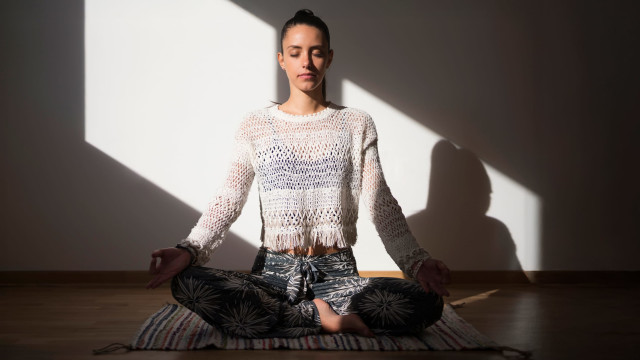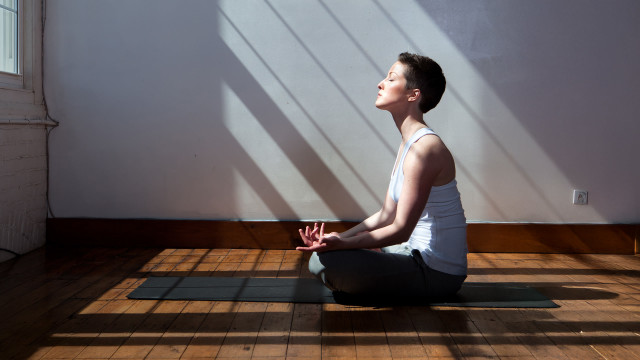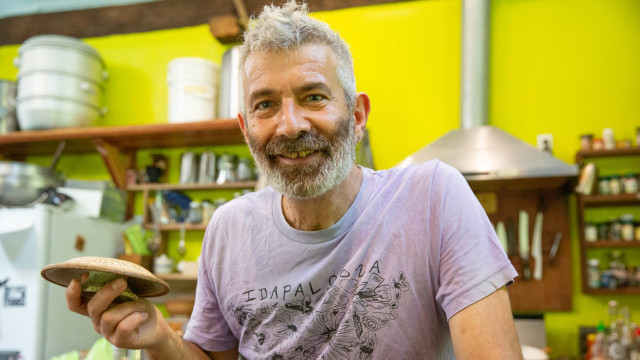5 Common Myths of Meditation

Meditation has profound benefits and is often used as a tool for reducing anxiety and calming our busy minds. Research shows that meditation can also result in physiological benefits, such as reduced blood pressure, helping to support blood flow to the brain, and increased efficiency in the brain’s executive attention network.
In her Roundglass course Meditation Made Easy, Almeiri Santos teaches that meditation is widely available to anyone, anywhere, and doesn’t require any special props, location, or instruction. Don’t let your mind trap you in a cycle of thinking you can’t meditate. Here, we highlight some common misconceptions about the practice of meditation and extend an invitation to sit.
Meditation Myth 1: Meditation Isn’t For Me
The idea of meditation can feel overwhelming, and many people believe they cannot meditate. But why? It’s easy to think you can’t sit still for 15 minutes, especially when you’ve never given it a genuine try. As soon as our minds start wandering, we reach for our phones or start fretting about to-do lists.
This can feel like we’ve failed, and it’s easy to talk ourselves out of committing to meditation, convinced we’ll never be able to clear our minds or even find the time to sit.
Just like any other exercise, we have to build up meditation muscles. “Do you expect to work out once a week and have a fit body?” asks meditation teacher and reiki master Almeiri Santos. Just like exercising at the gym, while meditation practice may feel uncomfortable at first, most practitioners tend to settle in and enjoy it over time.
Meditation is for everyone. It’s been shown to reduce stress and anxiety, improve sleep, and it’s accessible to anyone, anywhere. Here, a simple practice that demystifies meditation for beginners.
Try this Roundglass meditation course: Meditation Made Easy with meditation teacher and reiki master Almeiri Santos.
Meditation Myth 2: Your Mind Must Be Empty to Meditate
Many people come to meditation expecting to close their eyes and suddenly experience a clear mind and sense of peace. Still, anyone who has tried to meditate knows how it goes: Our minds race, our bodies scream, and our inner chatter often gets the best of us.
Wouldn't it be lovely to simply will away our thoughts and channel inner peace?
The truth every meditator will tell you is that thoughts come and go when we sit and focus. Meditation teachers often compare these wandering thoughts to clouds – watch your thoughts as you would watch the clouds, passing over and impermanent. In this watching of our thoughts, we create a little space – a gap between our thoughts. It is in this space where the benefits of meditation begin.
When we can "gracefully transition from any expectation of how you believe you are supposed to feel into simply letting the experience of stillness become bigger," says Santos, we begin to experience the rewards of meditation. Sometimes, it's only 30 seconds of nothingness, but that short time can fuel your next sit.
Meditation Myth 3: I Don't Have Time to Meditate
When we rule our timelines, it allows for flexibility to welcome different ways to meditate without feeling like adding one more thing to our to-do lists. Our time, at its core, is defined by us and us alone — we are only as busy as we want to be.
And meditation doesn't need to be a long practice requiring you to block out time in your schedule. You can meditate first thing in the morning while your coffee is brewing or standing in line at the grocery. "To dedicate this short amount of time to yourself is not overwhelming — everybody has 30 seconds to spare," says Santos.
Throughout the day, stop for a moment and breathe in slowly. Then, let the breath out, slowly. When you close your eyes and shift into a micro-meditation, this brief time allows for a simple way to bring us into the present moment.
Meditation Myth 4: I Need to Sit Still
It's easy to think you will never be able to sit still during meditation. Our environment and culture have us constantly on the move, juggling work, family, and obligations. But it's precisely those of us who feel we can't slow down that meditation can benefit the most.
When starting a meditation practice, throw out any rules you have in your mind about posture, cushions, and stillness. Step into the practice treating meditation as a great experiment, an exploration, and an adventure. Inevitably a limb may grow tired, or your arm will itch — feel free to change position and take care of yourself, returning to the meditation immediately after. In this way, we train our brains to settle, not to give up altogether.
"What you are looking for in a meditation practice is to become familiar with glimpsing your mind and giving in to the nature of consciousness itself," says Santos. By simply letting the experience unfold, we naturally open up doorways to stillness. Sitting still won't get you there any faster, so it's best to relax, observe and give it a try.
Meditation Myth 5: There Is a 'Right' Way to Meditate
Plain and simple, there is no one way to meditate correctly. Some people like to do it seated, and some prefer a chair to a floor cushion. You may want to meditate first thing in the morning, while others gravitate toward an evening practice. Play soft music, listen to a guided meditation or sit in silence.
There is no one way to meditate!
While there are many meditation styles to choose from, you will always benefit from any practice's cognitive and emotional payoffs. Time in stillness leads to a deeper connection with ourselves and brings a new perspective into our daily routines.
"We can use the concepts of awareness in the most simple and trivial aspects of everyday life, just as we are. With no need to fix or change anything," says Santos. When you don't have to do something right, it's impossible to get it wrong.
Key Takeaways
- Meditation is for everyone.
- Meditating helps you connect with yourself







